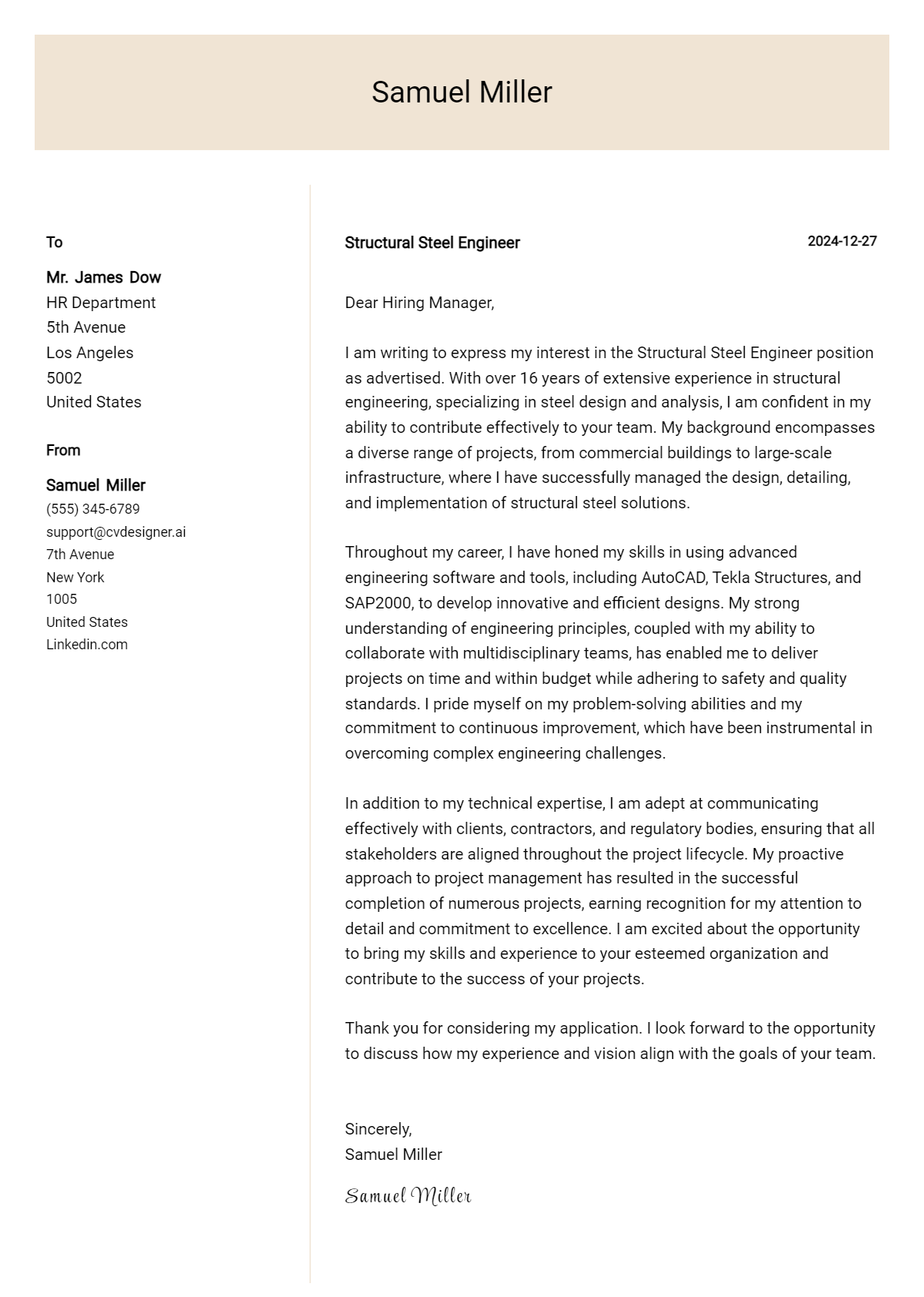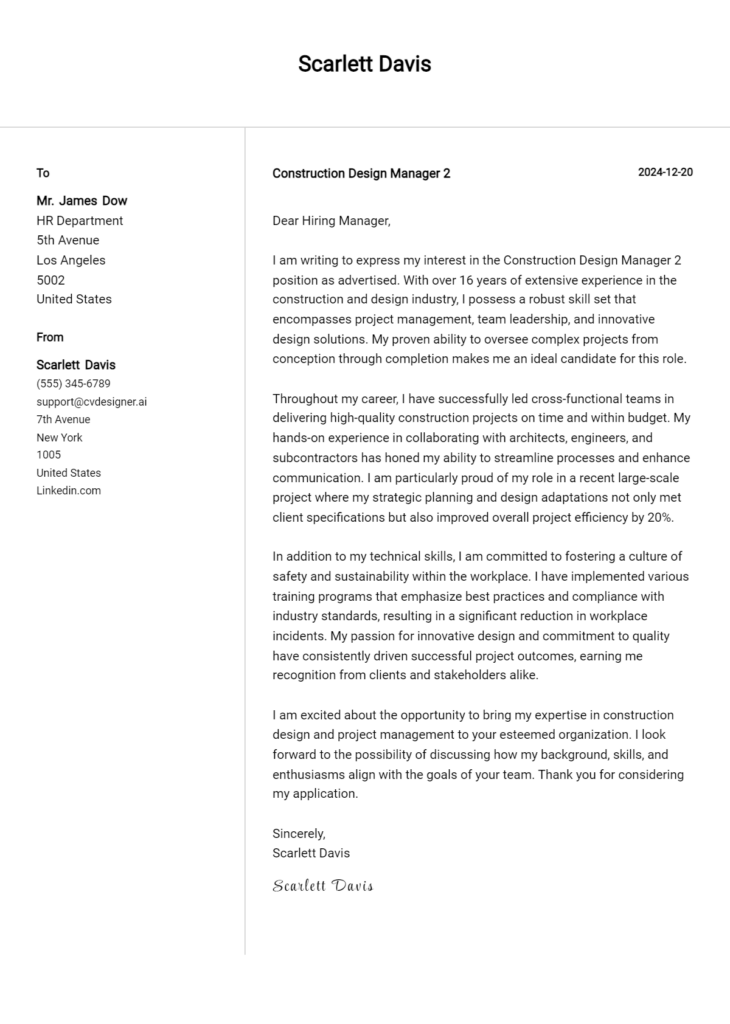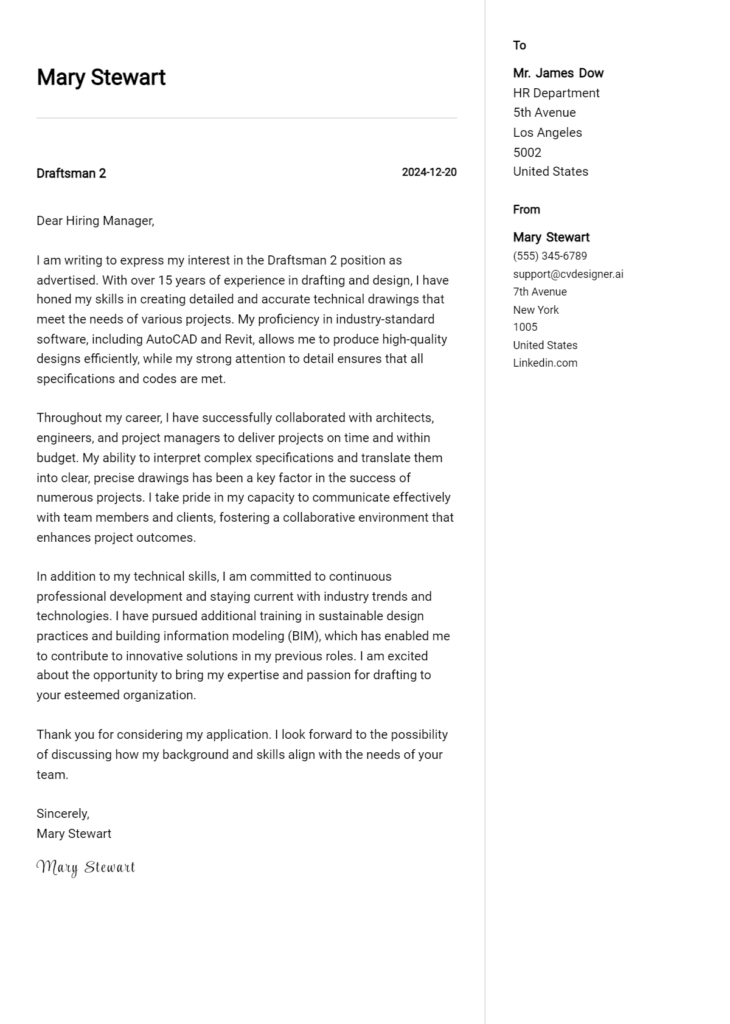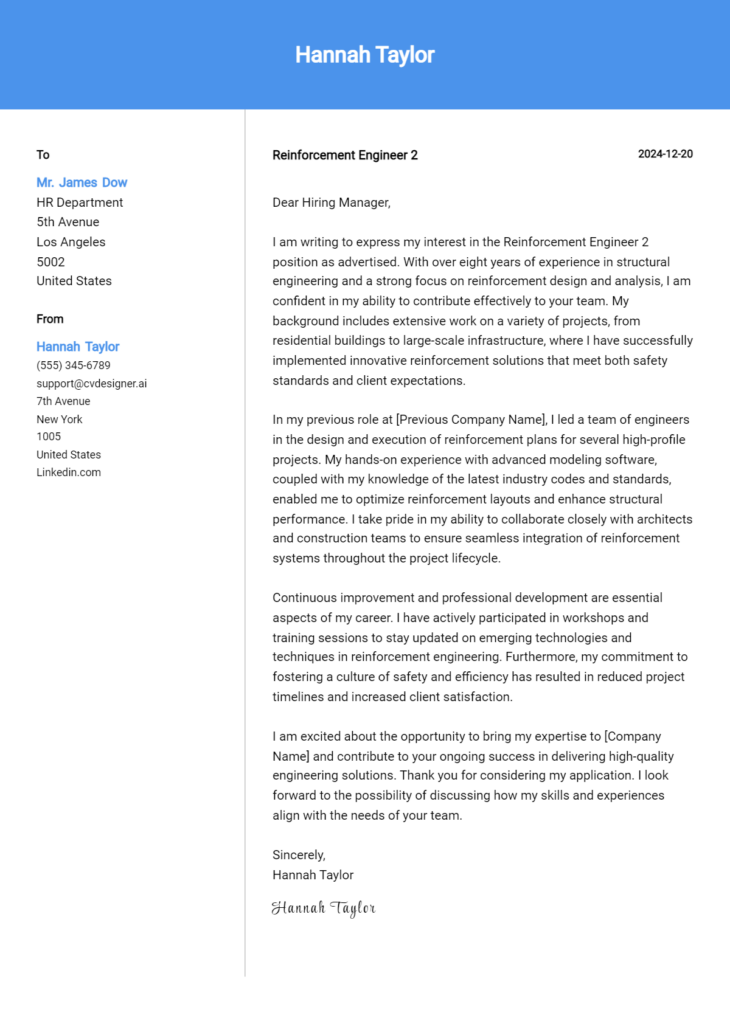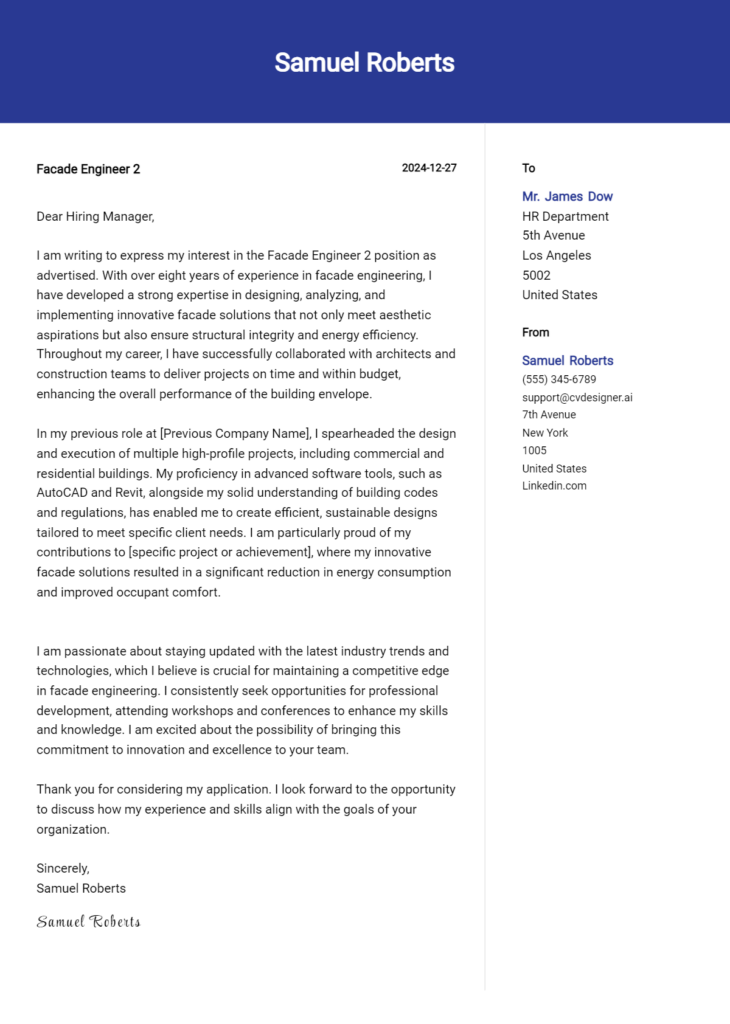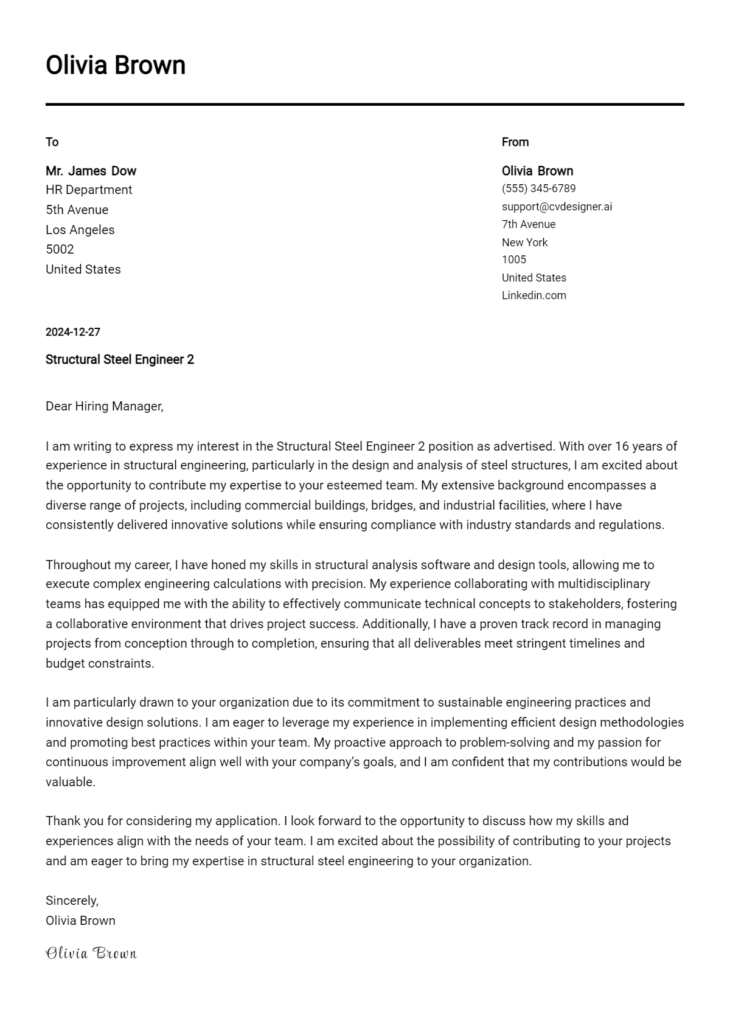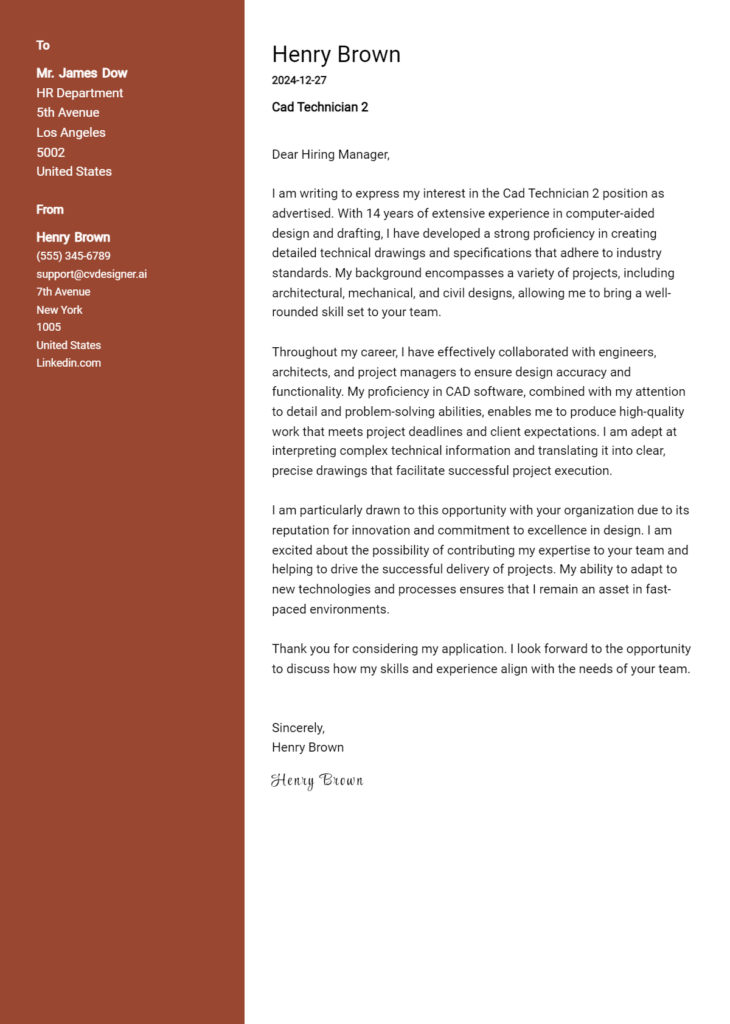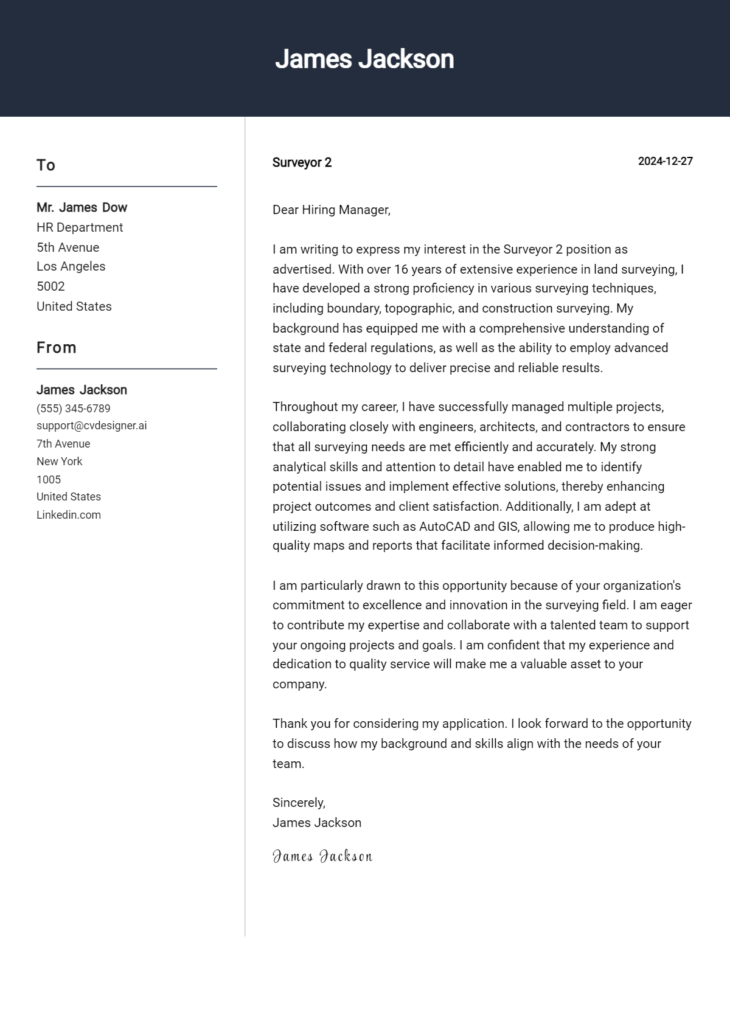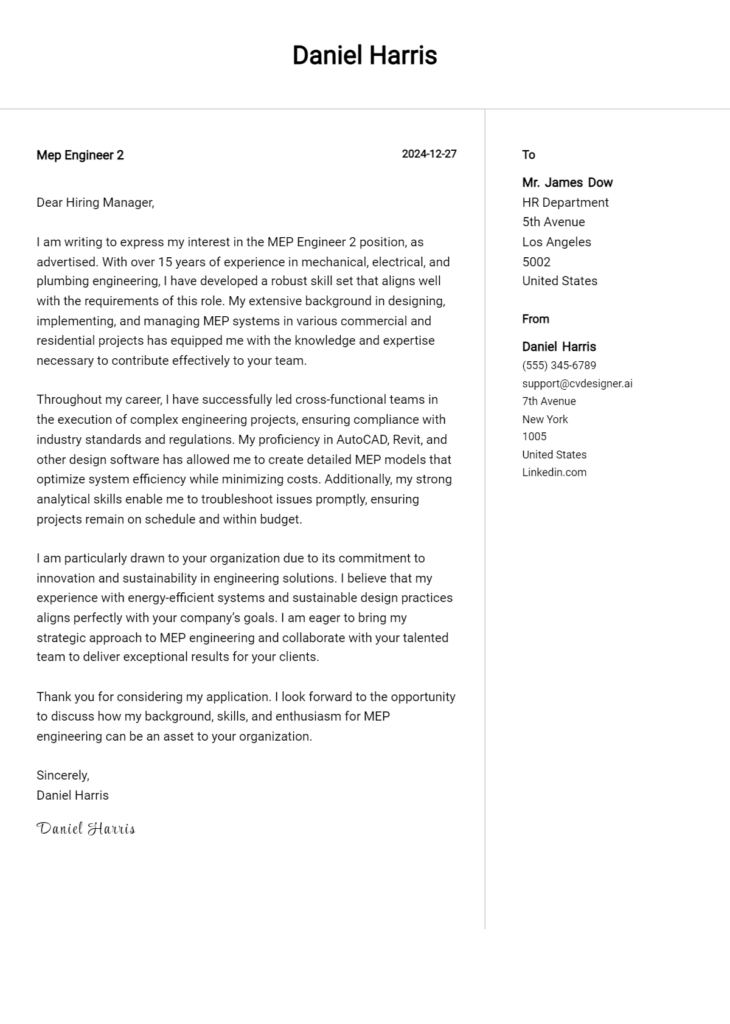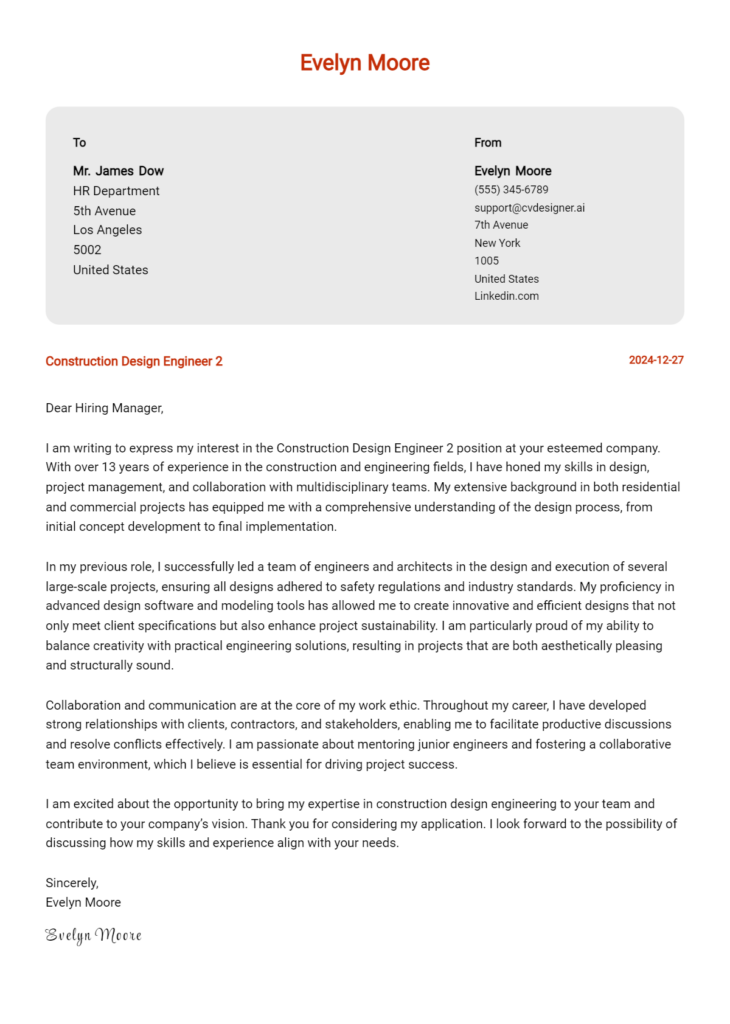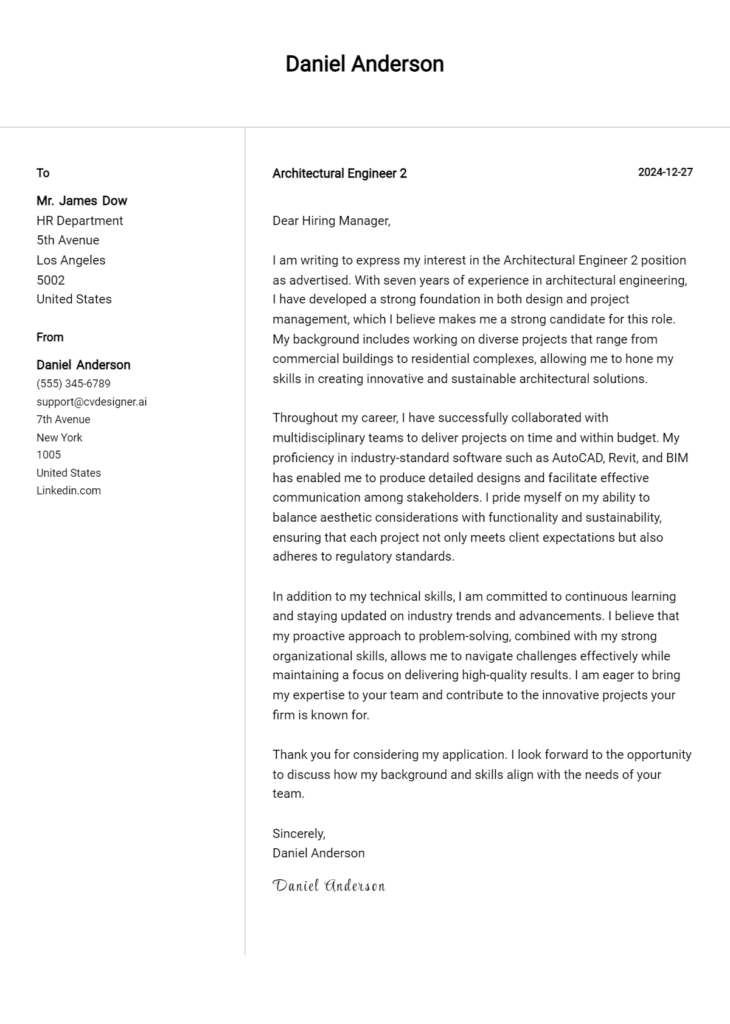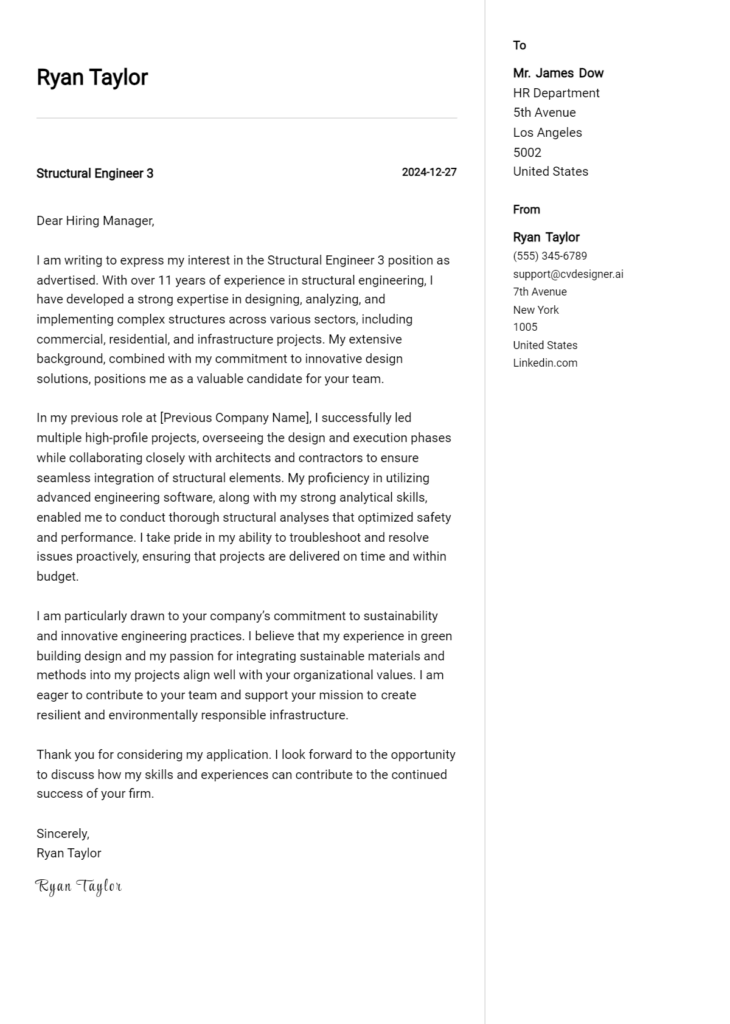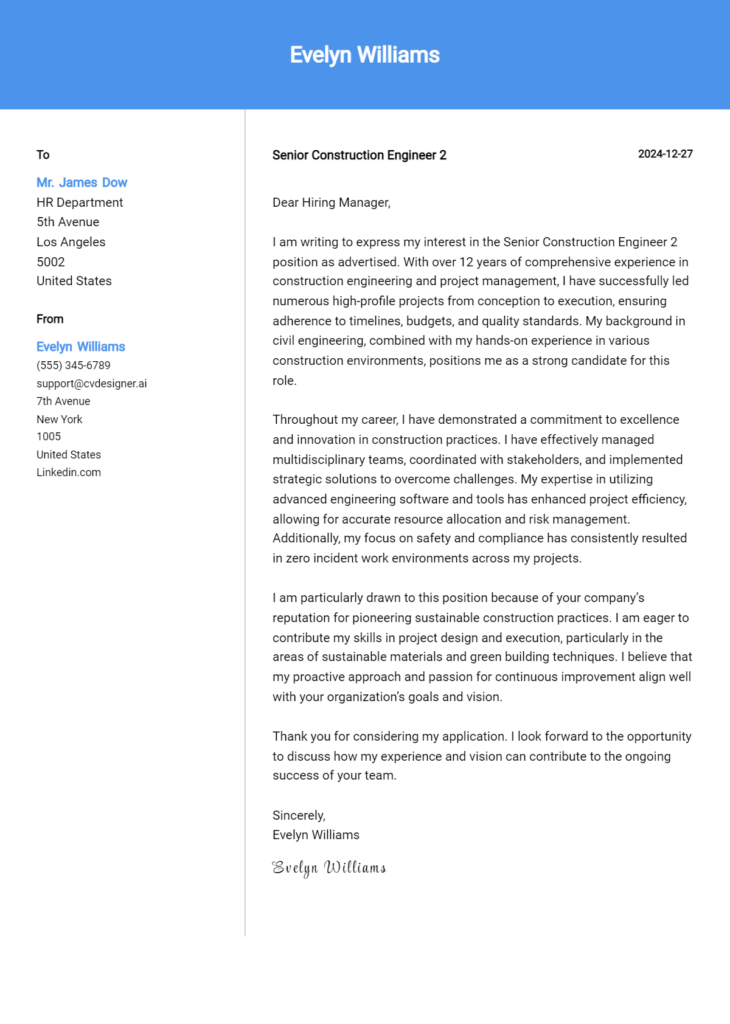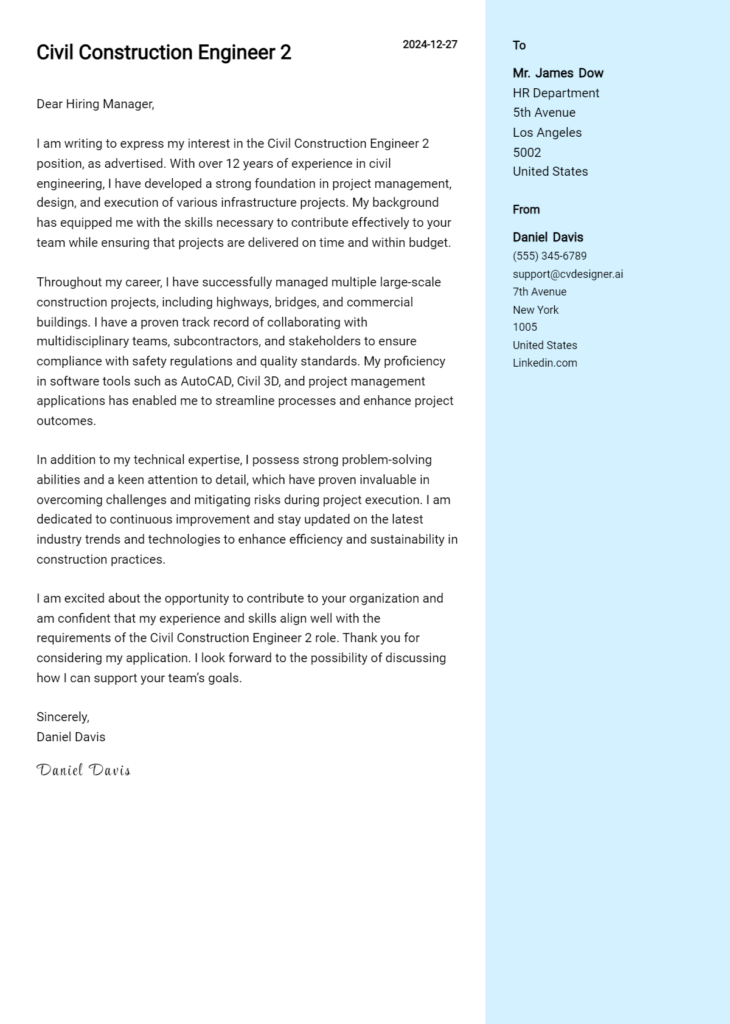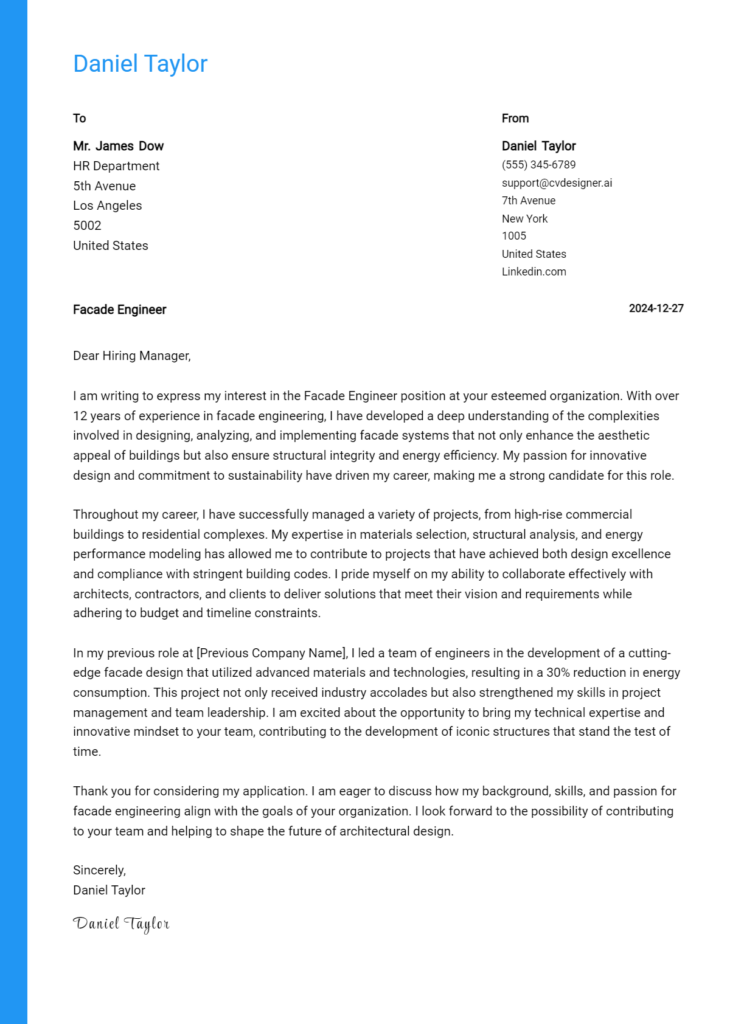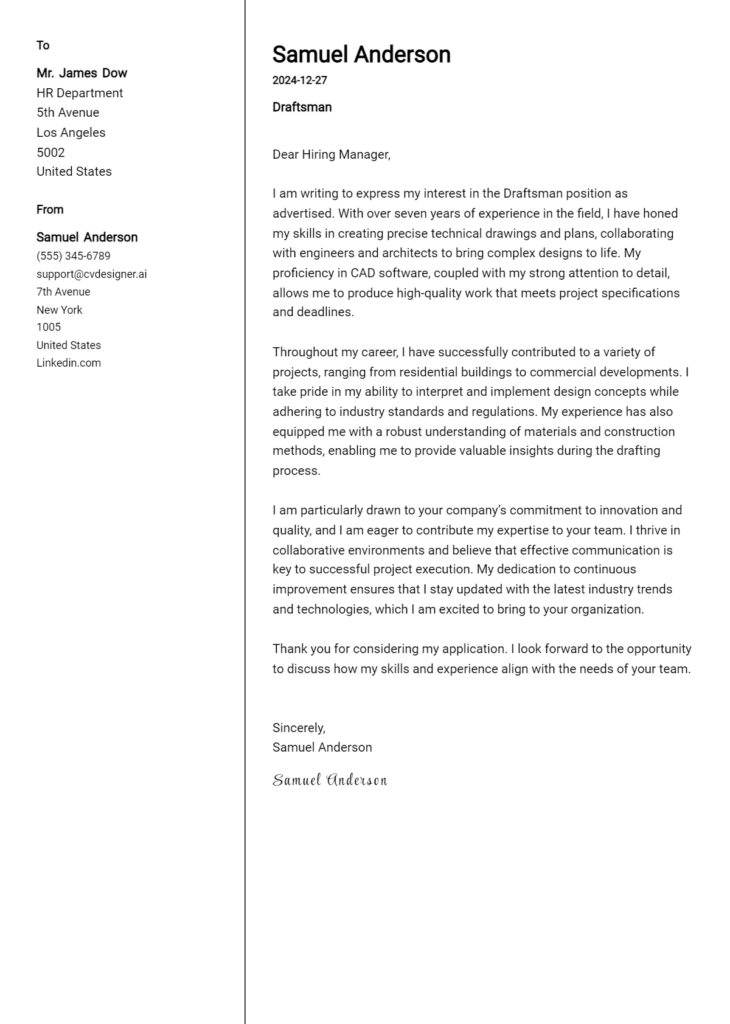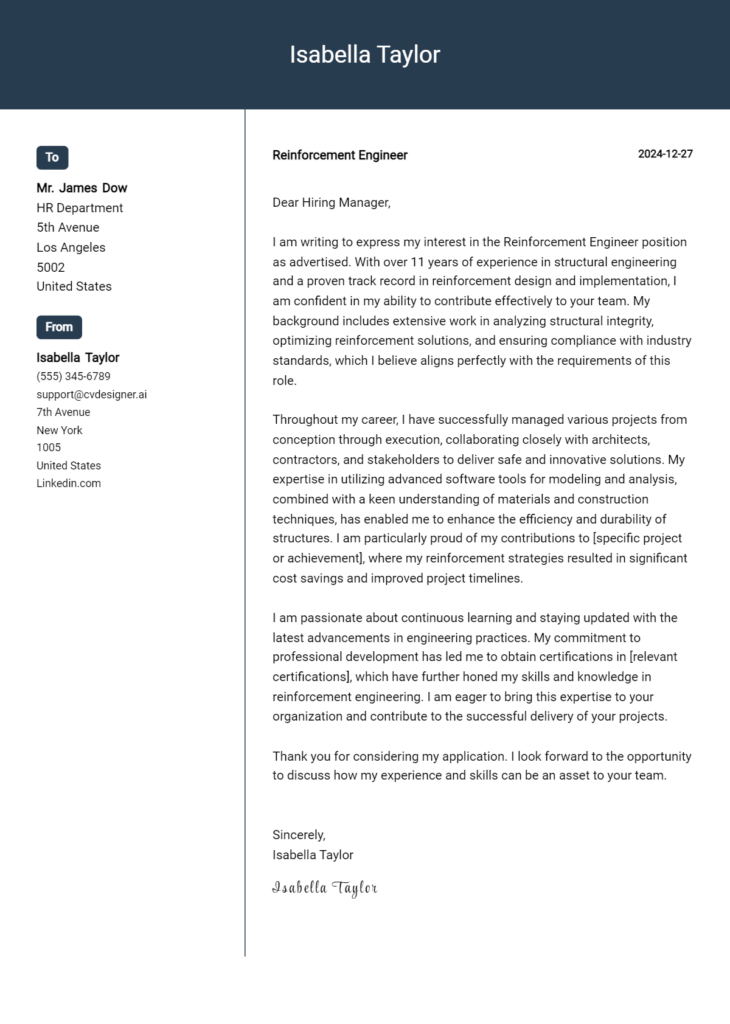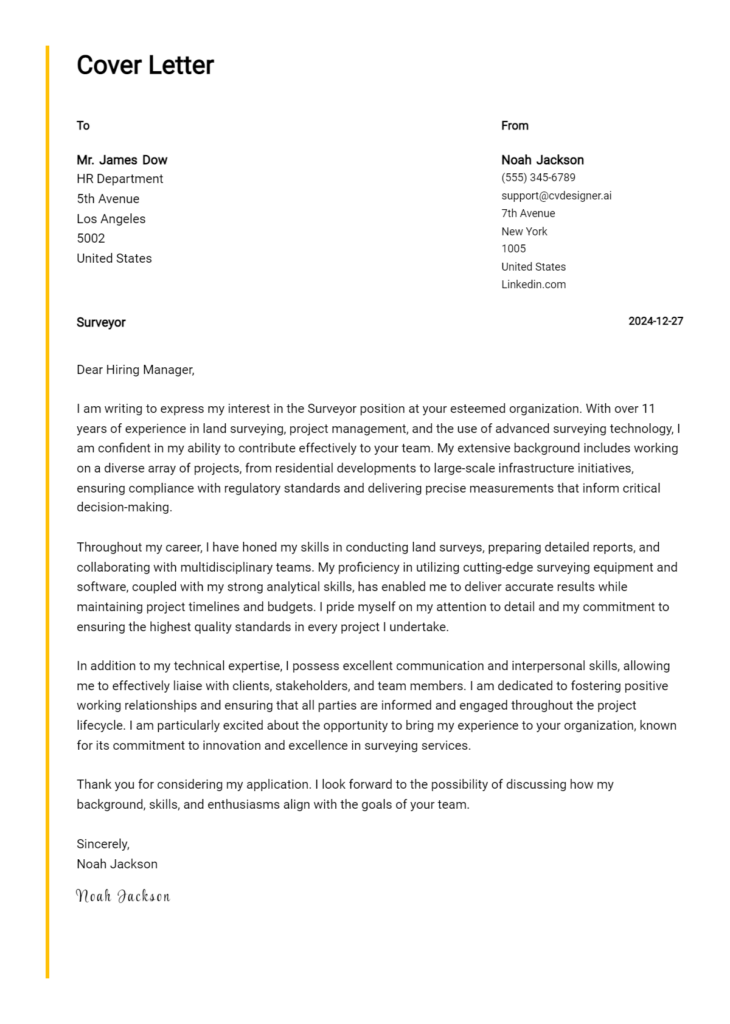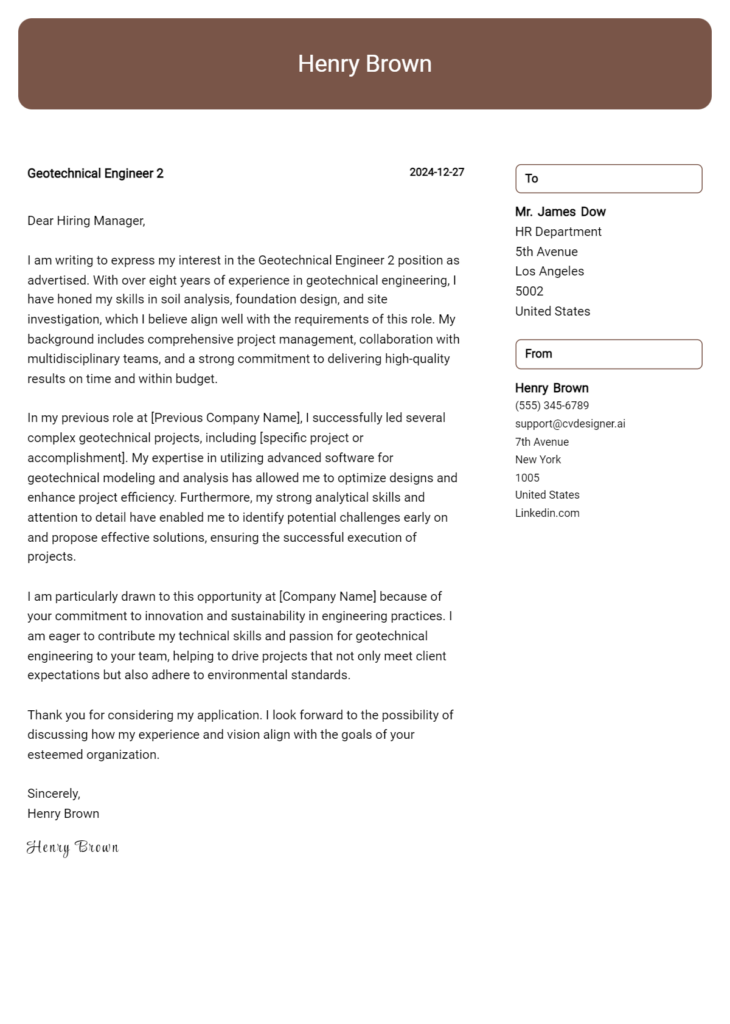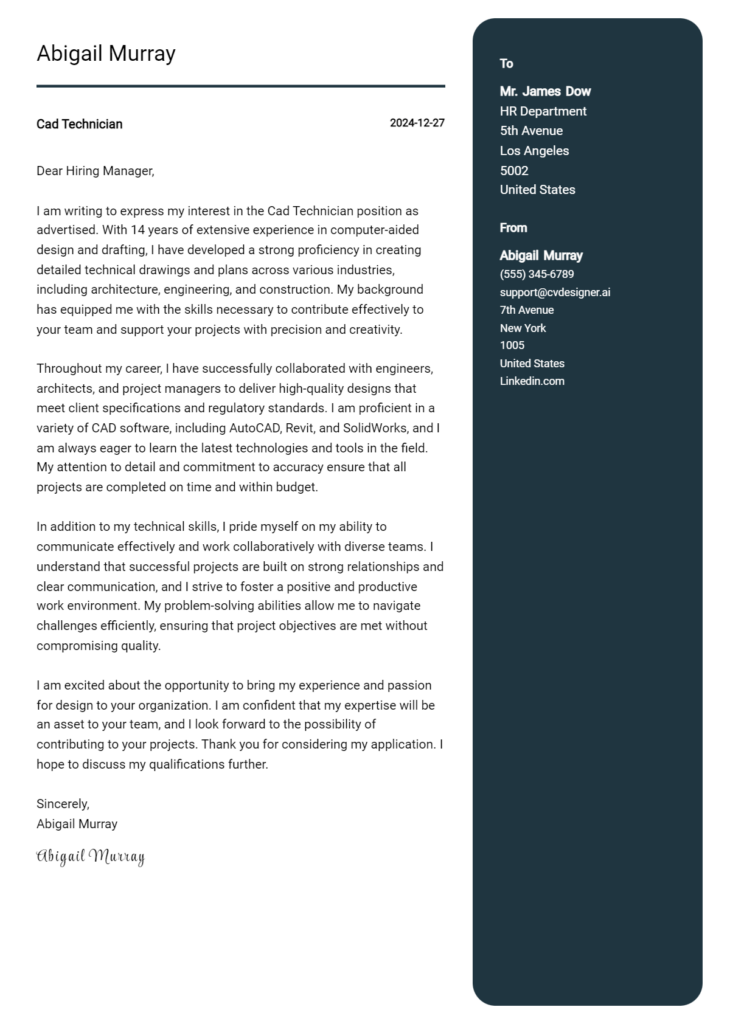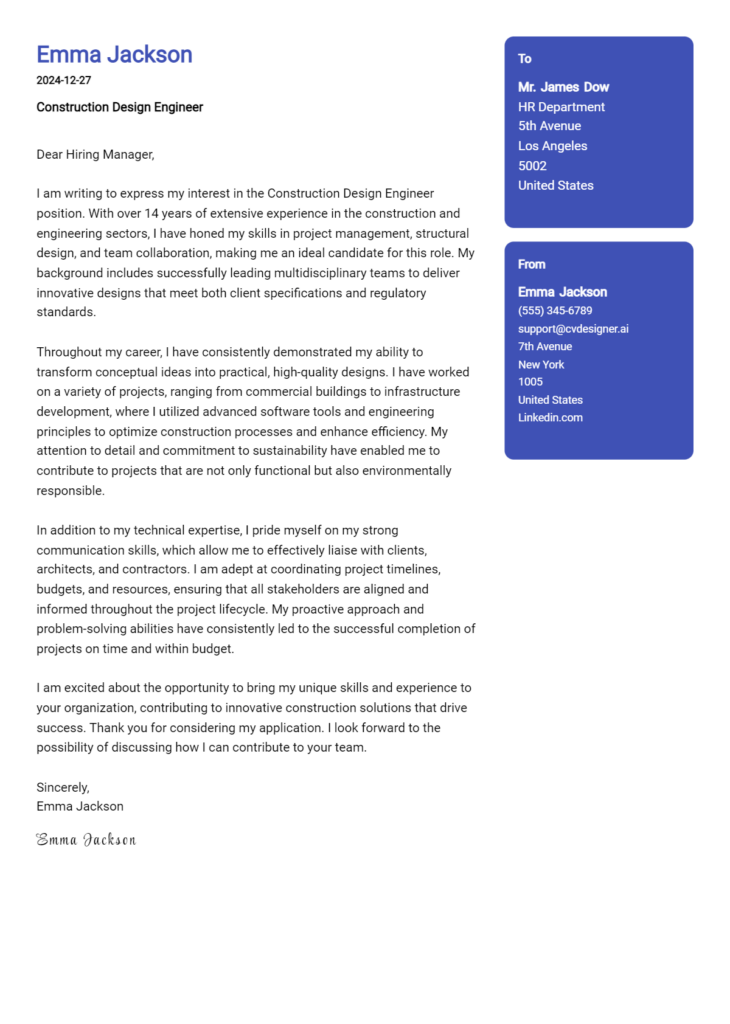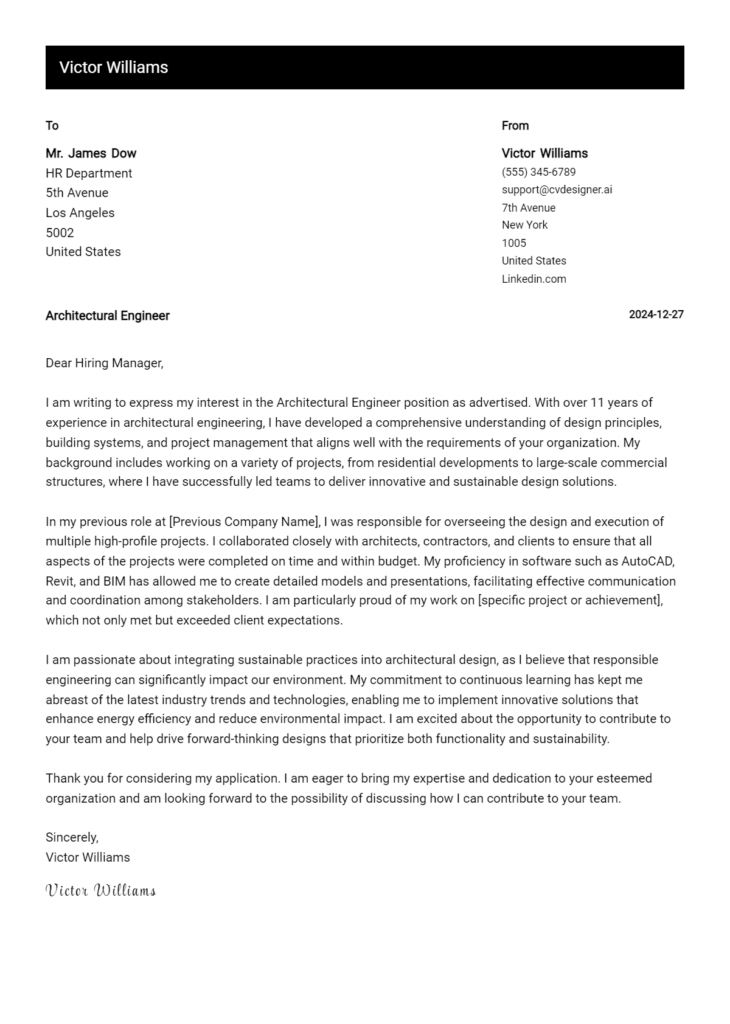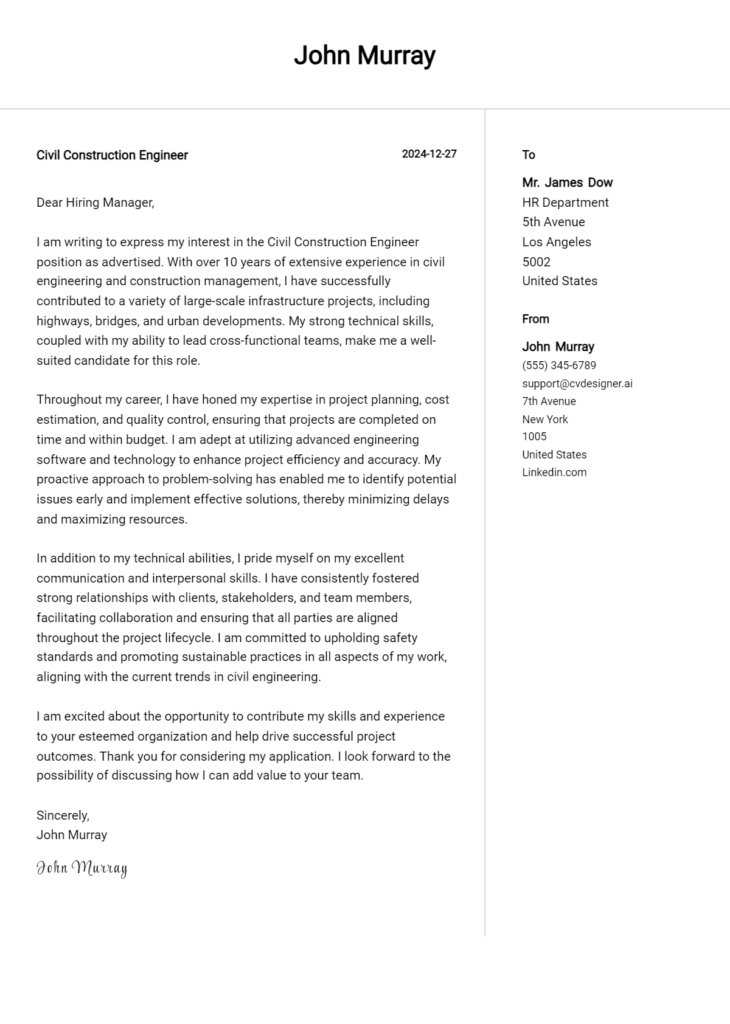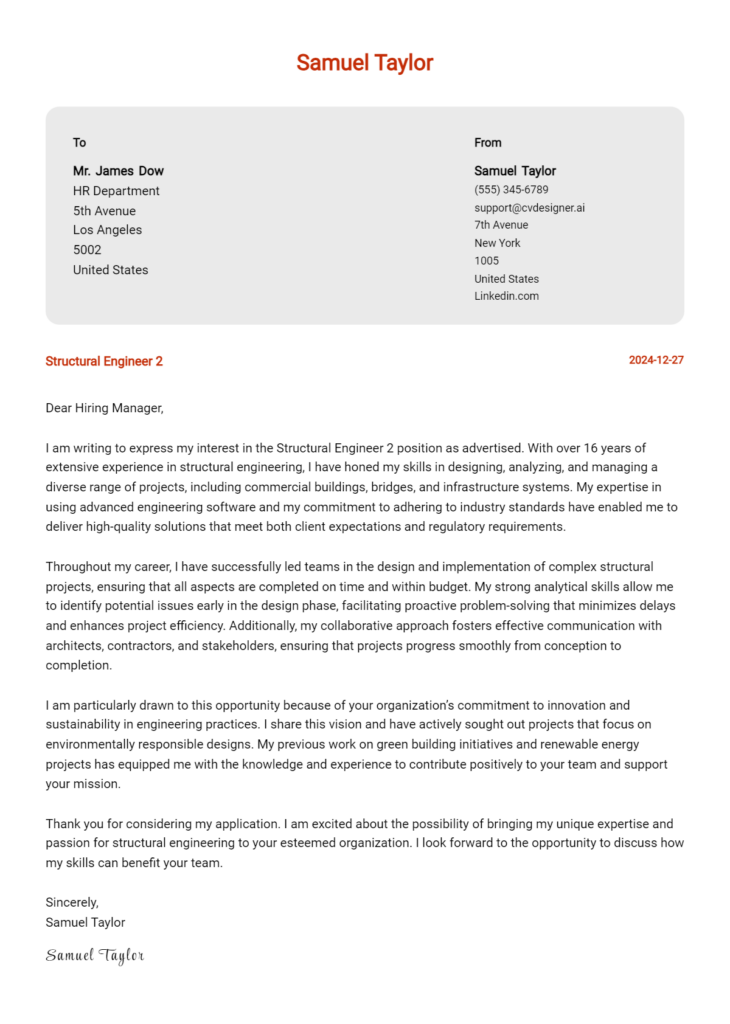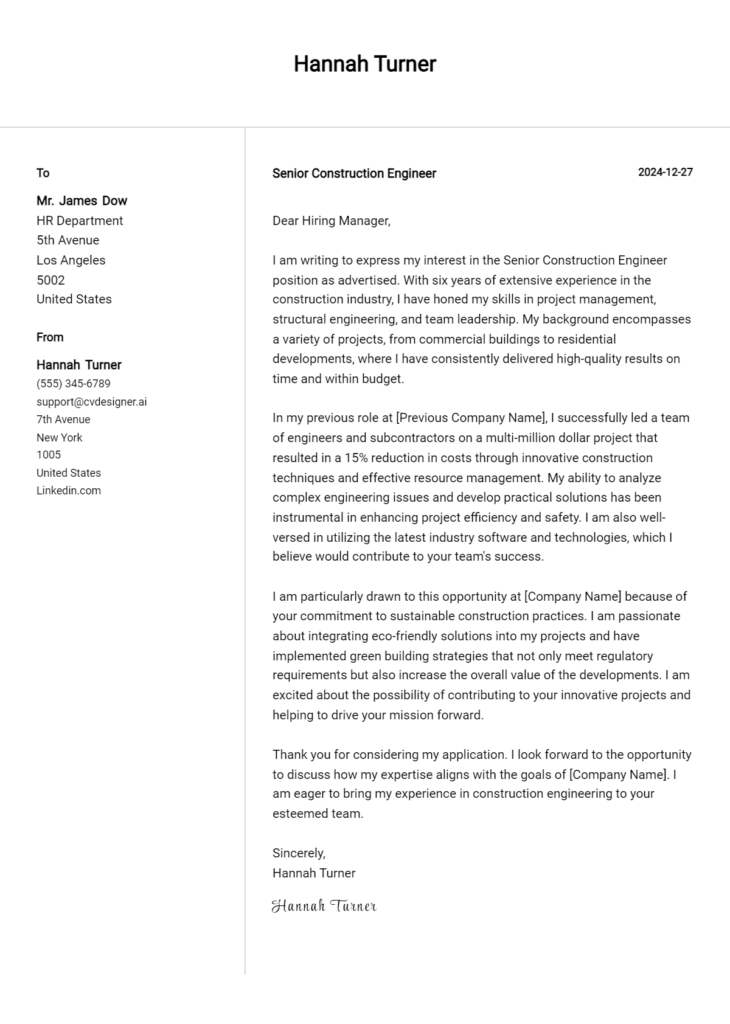Structural Steel Engineer Cover Letter Examples
Explore additional Structural Steel Engineer cover letter samples and guides and see what works for your level of experience or role.
How to Format a Structural Steel Engineer Cover Letter?
Crafting a compelling cover letter is essential for a Structural Steel Engineer, as it serves as your first opportunity to make a lasting impression on potential employers. The way you format your cover letter not only reflects your technical expertise but also your ability to convey complex information clearly and effectively. A well-structured cover letter can highlight your problem-solving skills, attention to detail, and commitment to safety—traits that are crucial in the engineering field.
In this guide, we will discuss the key components of a professional cover letter, providing insights and examples tailored specifically for Structural Steel Engineers.
We'll focus on the essential elements of a successful cover letter, including:
- Cover Letter Header
- Cover Letter Greeting
- Cover Letter Introduction
- Cover Letter Body
- Cover Letter Closing
Each section is vital in demonstrating your qualifications and professionalism. Let’s delve into each part and explore how to create a standout cover letter that showcases your engineering prowess.
Importance of the Cover Letter Header for a Structural Steel Engineer
The cover letter header is a critical component of your application as a Structural Steel Engineer. It serves as the first impression to potential employers and sets the tone for the rest of your correspondence. A well-structured header provides clarity and professionalism, ensuring that your contact information, the date, and the recipient's details are easily identifiable. This not only facilitates communication but also demonstrates your attention to detail, which is essential in the engineering field.
A strong header includes your name, address, phone number, and email address, followed by the date and the recipient's name, title, company, and address. In contrast, a weak header may lack crucial information or have formatting errors, which could detract from your professionalism.
Strong Example:
John Doe 123 Engineering Lane City, State, ZIP (123) 456-7890 johndoe@email.com October 20, 2023 Mr. Smith Johnson Hiring Manager ABC Engineering Solutions 456 Construction Ave City, State, ZIP
Weak Example:
John 123 Lane (123) 456-7890 10/20/23 To Whom It May Concern,
The Importance of the Cover Letter Greeting
The greeting of a cover letter sets the tone for the entire document and is a crucial first step in making a positive impression on a potential employer. A well-crafted greeting not only demonstrates professionalism but also conveys a sense of personalization, making the hiring manager feel recognized and valued. By addressing the recipient directly, you show that you have taken the time to research their name and role within the company, which can differentiate you from other candidates who may use a generic salutation. To avoid generic greetings, it's essential to either find the hiring manager's name through the company's website, LinkedIn, or by calling the company directly. This effort reflects your genuine interest in the position and the organization.
Strong Greeting Example
Dear Mr. Smith,
Weak Greeting Example
To Whom It May Concern,
By choosing a strong greeting, you establish a connection with the reader and set a positive tone for the rest of your cover letter, while a weak greeting can come across as impersonal and disengaged.
The Importance of a Well-Crafted Cover Letter Introduction for a Structural Steel Engineer
A compelling cover letter introduction is crucial for a Structural Steel Engineer, as it serves as the first impression to the hiring manager. This introduction should not only capture their attention but also convey the candidate’s enthusiasm for the role. By briefly highlighting relevant skills and achievements, the introduction sets the tone for the rest of the cover letter, compelling the reader to learn more about the applicant. A strong introduction can differentiate a candidate in a competitive field, while a weak one may lead to missed opportunities. Below are examples of effective and ineffective introductions for a Structural Steel Engineer cover letter.
Strong Example
Dear Hiring Manager, I am excited to apply for the Structural Steel Engineer position at [Company Name], where I can leverage my 8 years of experience in designing and analyzing complex steel structures. My recent project, which involved the successful completion of a multi-million-dollar bridge, not only highlighted my technical expertise but also showcased my ability to lead a team through challenging timelines and deliver exceptional results. I am eager to bring my passion for innovative engineering solutions to your esteemed company.
Weak Example
To whom it may concern, I saw the job posting for a Structural Steel Engineer and thought it looked interesting. I have some experience in this field and I think I could do the job. I hope you consider my application.
Cover Letter Body for Structural Steel Engineer
The body of a cover letter for a Structural Steel Engineer serves as a critical platform for candidates to effectively communicate their technical expertise, relevant experiences, and unique contributions to the prospective employer. By detailing specific projects they have worked on, such as the design and implementation of complex structural systems or successful collaborations in large-scale construction projects, candidates can demonstrate their problem-solving abilities and project management skills. This section should not only highlight their qualifications but also illustrate how their background aligns with the company's goals and values, making a compelling case for why they are the ideal fit for the role.
Strong Example
I am excited to apply for the Structural Steel Engineer position at XYZ Corporation, as I believe my extensive background in designing and executing structural systems aligns perfectly with your team's objectives. During my tenure at ABC Engineering, I led a project to design a 200,000 square foot commercial facility, where I successfully implemented innovative steel framing solutions that reduced material costs by 15%. My experience in collaborating with architects and contractors, combined with my proficiency in advanced structural analysis software, has equipped me with the skills necessary to contribute effectively to your projects. I am particularly drawn to your commitment to sustainable engineering practices, and I am eager to bring my expertise in environmentally conscious design to your esteemed company.
Weak Example
I want to apply for the Structural Steel Engineer job. I have worked on some projects before and know a bit about steel. I think I can do well in this role. My last job was okay, and I did some calculations. I am interested in the company and would like to help with engineering tasks.
Importance of the Cover Letter Closing for a Structural Steel Engineer
The closing paragraph of a cover letter is crucial for leaving a lasting impression on the hiring manager. It serves as a summary of your qualifications, reiterates your enthusiasm for the position, and encourages the reader to take the next steps, such as reviewing your resume or scheduling an interview. A strong closing can effectively highlight your suitability for the role and your eagerness to contribute to the company, while a weak closing may miss the opportunity to reinforce your candidacy.
Strong Example
Thank you for considering my application for the Structural Steel Engineer position. With my extensive experience in structural design and my commitment to safety and efficiency, I am excited about the possibility of contributing to your team. I look forward to the opportunity to discuss my qualifications further and explore how I can help achieve your company's goals. Please feel free to contact me to schedule an interview at your earliest convenience.
Weak Example
I hope to hear back from you soon. I think I could be a good fit for the job. Please let me know if you need any more information.
These tips will help you craft an effective cover letter for a Structural Steel Engineer position by emphasizing your technical skills, problem-solving abilities, knowledge of the Software Development Life Cycle (SDLC), teamwork experience, and a passion for continuous learning. A well-written cover letter can set you apart from other candidates by clearly demonstrating your qualifications and enthusiasm for the role.
Cover Letter Writing Tips for Structural Steel Engineer
Showcase Your Technical Skills: As a Structural Steel Engineer, it's crucial to highlight your technical expertise. Mention specific software you are proficient in, such as AutoCAD, Revit, or SAP2000. Detail any relevant certifications or training, and provide examples of how you have applied these skills in previous projects. This demonstrates your capability and readiness for the role.
Emphasize Problem-Solving Abilities: Structural engineering often involves overcoming complex challenges. Use your cover letter to describe a particular problem you faced in a past project and how you approached it. Explain the steps you took to analyze the situation and the successful outcome. This not only showcases your critical thinking but also your resilience and resourcefulness.
Highlight SDLC Knowledge: If you have experience with the Software Development Life Cycle (SDLC), make sure to mention it. Outline your familiarity with various phases of SDLC and how this knowledge has helped you in engineering projects. This is especially relevant if you're applying for positions that require collaboration with software developers or project management roles.
Demonstrate Teamwork and Collaboration: Structural engineering projects often require the input of multiple stakeholders. Share examples of your experience working in teams, whether in academic settings, internships, or professional environments. Highlight your ability to communicate effectively, listen to others, and contribute to group efforts, as this demonstrates your capacity to work collaboratively.
Express a Passion for Continuous Learning: The field of structural engineering is always evolving, and employers value candidates who are committed to lifelong learning. Mention any recent courses, workshops, or certifications you have pursued to stay updated with industry trends and technologies. This shows that you are proactive about your professional development and enthusiastic about contributing to innovative projects.
By following these tips, you can create a compelling cover letter that effectively showcases your qualifications as a Structural Steel Engineer. For further assistance, you may explore various cover letter templates or utilize a cover letter builder to streamline your writing process.
Common Mistakes to Avoid in a Structural Steel Engineer Cover Letter
Crafting a compelling cover letter is essential for standing out in the competitive field of structural engineering. Avoiding common mistakes not only enhances your professionalism but also increases your chances of landing an interview. Here are some frequent pitfalls to watch out for:
Generic Content: Using a one-size-fits-all approach can make your letter blend in with the rest. Tailor your cover letter to the specific job and company by mentioning relevant projects and skills.
Lack of Specificity: Failing to provide concrete examples of your experience or achievements can weaken your application. Highlight specific projects you've worked on, particularly those that demonstrate your expertise in structural steel design.
Ignoring the Format: A poorly formatted cover letter can detract from your qualifications. Adhere to a professional cover letter format to ensure clarity and readability.
Overly Technical Language: While technical knowledge is important, using excessive jargon can alienate non-engineering readers. Strive for a balance that showcases your expertise while remaining accessible.
Neglecting Proofreading: Spelling and grammatical errors can undermine your credibility. Always proofread your cover letter multiple times and consider having someone else review it as well.
Focusing Solely on Responsibilities: Concentrating on duties rather than achievements can make your experience seem less impactful. Emphasize how your contributions made a difference in your previous roles.
Not Including a Call to Action: Failing to indicate your desire for an interview can leave your application feeling incomplete. End with a strong closing statement inviting further discussion about your qualifications.
By avoiding these common mistakes, you can create a more effective cover letter that showcases your skills and professionalism. For inspiration, check out these cover letter examples.
Cover Letter FAQs for Structural Steel Engineer
What should I include in my cover letter as a Structural Steel Engineer?
Your cover letter should begin with a strong introduction that states the position you are applying for and where you found the job listing. Highlight your relevant experience in structural design, detailing, and analysis, focusing on specific projects that demonstrate your expertise in steel construction. Include technical skills like proficiency in software such as AutoCAD, SAP2000, or Revit. Don't forget to mention any certifications (e.g., PE license) that are pertinent to the role. Finally, express enthusiasm for the company and how your skills align with their projects and values.
How do I showcase my technical skills in my cover letter?
To effectively showcase your technical skills, use specific examples from your past work experience. Instead of simply listing skills, describe how you applied them in practical scenarios. For instance, mention a project where you utilized software to optimize structural designs or how your knowledge of codes and regulations ensured compliance during construction. Quantify your achievements, if possible, such as reducing material costs by a certain percentage or improving project timelines. This approach not only highlights your skills but also illustrates your impact on previous projects.
How can I make my cover letter stand out?
To make your cover letter stand out, personalize it for the specific job and company. Research the organization and mention any notable projects or values that resonate with you. Use a confident and professional tone while maintaining clarity and conciseness. Highlight unique aspects of your experience, such as innovative solutions you've implemented in past roles or leadership in cross-disciplinary teams. Including a brief anecdote or a challenge you overcame can add a personal touch that engages the reader. Finally, ensure your formatting is clean and professional to make a strong visual impression.
Should I address any gaps in my employment history in my cover letter?
Yes, addressing gaps in employment can be beneficial, but it's essential to do so briefly and positively. If you have a gap due to further education, personal development, or family responsibilities, mention it in a way that demonstrates growth or skill acquisition. For instance, if you took time off to pursue a certification in structural engineering, highlight how that knowledge has prepared you for the role you're applying for. Avoid overly lengthy explanations; keep it concise and focus on how your experiences during that time have made you a better candidate for the position.
Build your Cover Letter in minutes
Use an AI-powered cover letter builder and have your letter done in 5 minutes. Just select your template and our software will guide you through the process.

